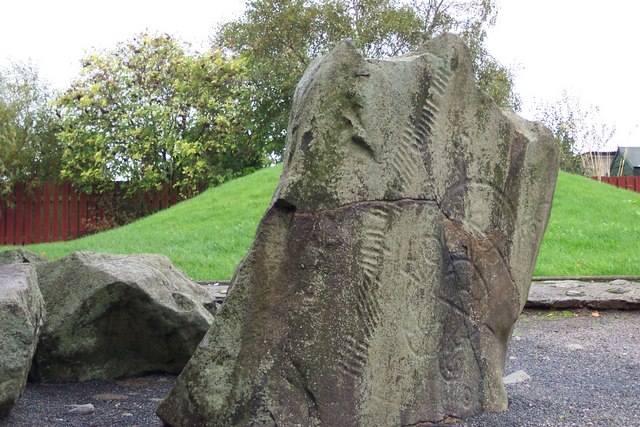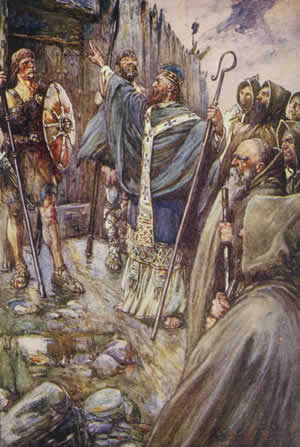|
Brandsbutt Stone
The Brandsbutt Stone is a class I Pictish symbol stone in Inverurie, Aberdeenshire, Scotland. Description A large block of whinstone, high, wide and deep, the stone had been broken up and used in building a dry stone wall before 1866. The stone, now reassembled, bears two incised Pictish symbols, a crescent and v-rod and a serpent and z-rod, and an inscription in Ogham, ''IRATADDOARENS''. The carvings of the Brandsbutt Stone are dated to around AD 600. It is a scheduled monument. Inscription The inscription borne by the Brandsbutt Stone, ''IRATADDOARENS'', has been described by Katherine Forsyth as appearing to be "utterly baffling". However, a handful of interpretations have been offered. Suggestions include the possibility that it may contain a corrupted version of the personal name ''Ethernan''. If this is the case, it is likely to refer to the 7th century saint Ethernan about whom little is known but who was apparently venerated by the Picts. He is referred to in an ... [...More Info...] [...Related Items...] OR: [Wikipedia] [Google] [Baidu] |
Katherine Forsyth
Katherine S. Forsyth is a Scottish historian who specializes in the history and culture of Celtic-speaking peoples during the 1st millennium AD, in particular the Picts. She is currently a professor iCeltic and Gaelicat the University of Glasgow in Scotland. Forsyth is an expert in the Ogham script, and has provided readings for a number of Ogham inscriptions, including the Buckquoy spindle-whorl and the Lunnasting stone The Lunnasting stone is a stone bearing an ogham inscription, found at Lunnasting, Shetland and donated to the National Museum of Antiquities of Scotland in 1876. Discovery The stone was found by Rev. J.C. Roger in a cottage, who stated that it .... Forsyth has reinterpreted a number of Pictish Ogham stone inscriptions that were previously thought to be written in an unknown pre-Indo-European language, and has argued that the Picts spoke a Brythonic language.Forsyth (1997) Works * 1995.The ogham-inscribed spindle-whorl from Buckquoy: evidence for the Ir ... [...More Info...] [...Related Items...] OR: [Wikipedia] [Google] [Baidu] |
Pictish Stones In Aberdeenshire
Pictish is the extinct Brittonic language spoken by the Picts, the people of eastern and northern Scotland from Late Antiquity to the Early Middle Ages. Virtually no direct attestations of Pictish remain, short of a limited number of geographical and personal names found on monuments and the contemporary records in the area controlled by the kingdoms of the Picts, dating to the early medieval period. Such evidence, however, points strongly to the language being an Insular Celtic language related to the Brittonic language spoken prior to Anglo-Saxon settlement in what is now southern Scotland, England, and Wales. The prevailing view in the second half of the 20th century was that Pictish was a non-Indo-European language isolate, predating a Gaelic colonisation of Scotland or that a non-Indo-European Pictish and Brittonic Pictish language coexisted. Pictish was replaced by – or subsumed into – Gaelic in the latter centuries of the Pictish period. During the reign of Domnall ... [...More Info...] [...Related Items...] OR: [Wikipedia] [Google] [Baidu] |
Thomas K
Thomas may refer to: People * List of people with given name Thomas * Thomas (name) * Thomas (surname) * Saint Thomas (other) * Thomas Aquinas (1225–1274) Italian Dominican friar, philosopher, and Doctor of the Church * Thomas the Apostle * Thomas (bishop of the East Angles) (fl. 640s–650s), medieval Bishop of the East Angles * Thomas (Archdeacon of Barnstaple) (fl. 1203), Archdeacon of Barnstaple * Thomas, Count of Perche (1195–1217), Count of Perche * Thomas (bishop of Finland) (1248), first known Bishop of Finland * Thomas, Earl of Mar (1330–1377), 14th-century Earl, Aberdeen, Scotland Geography Places in the United States * Thomas, Illinois * Thomas, Indiana * Thomas, Oklahoma * Thomas, Oregon * Thomas, South Dakota * Thomas, Virginia * Thomas, Washington * Thomas, West Virginia * Thomas County (other) * Thomas Township (other) Elsewhere * Thomas Glacier (Greenland) Arts, entertainment, and media * ''Thomas'' (Burton no ... [...More Info...] [...Related Items...] OR: [Wikipedia] [Google] [Baidu] |
Breton Language
Breton (, ; or in Morbihan) is a Southwestern Brittonic language of the Celtic language family spoken in Brittany, part of modern-day France. It is the only Celtic language still widely in use on the European mainland, albeit as a member of the insular branch instead of the continental grouping. Breton was brought from Great Britain to Armorica (the ancient name for the coastal region that includes the Brittany peninsula) by migrating Britons during the Early Middle Ages, making it an Insular Celtic language. Breton is most closely related to Cornish, another Southwestern Brittonic language. Welsh and the extinct Cumbric, both Western Brittonic languages, are more distantly related. Having declined from more than one million speakers around 1950 to about 200,000 in the first decade of the 21st century, Breton is classified as "severely endangered" by the UNESCO ''Atlas of the World's Languages in Danger''. However, the number of children attending bilingual classes ... [...More Info...] [...Related Items...] OR: [Wikipedia] [Google] [Baidu] |
Pictish
Pictish is the extinct Brittonic language spoken by the Picts, the people of eastern and northern Scotland from Late Antiquity to the Early Middle Ages. Virtually no direct attestations of Pictish remain, short of a limited number of geographical and personal names found on monuments and the contemporary records in the area controlled by the kingdoms of the Picts, dating to the early medieval period. Such evidence, however, points strongly to the language being an Insular Celtic language related to the Brittonic language spoken prior to Anglo-Saxon settlement in what is now southern Scotland, England, and Wales. The prevailing view in the second half of the 20th century was that Pictish was a non-Indo-European language isolate, predating a Gaelic colonisation of Scotland or that a non-Indo-European Pictish and Brittonic Pictish language coexisted. Pictish was replaced by – or subsumed into – Gaelic in the latter centuries of the Pictish period. During the reign of Dom ... [...More Info...] [...Related Items...] OR: [Wikipedia] [Google] [Baidu] |
Fordoun Stone
The Fordoun Stone is a class II Pictish cross slab in Fordoun parish church, Auchenblae, Aberdeenshire Aberdeenshire ( sco, Aiberdeenshire; gd, Siorrachd Obar Dheathain) is one of the 32 Subdivisions of Scotland#council areas of Scotland, council areas of Scotland. It takes its name from the County of Aberdeen which has substantially differe ..., Scotland. Description A slab of Old Red Sandstone, the cross slab was discovered in the late 18th century, having been reused as paving in Fordoun Parish Church. The slab, now standing in the church bears a celtic cross with interlaced knotwork, a hunting scene and a double disc and z-rod design. It also bears inscriptions, Ogham script along the edges of the stone, VUN-MSETTORBBRE as well as an inscription in roman script, Pidarnoin, on the face of the slab. References External links {{Pictish stones Pictish stones Pictish stones in Aberdeenshire ... [...More Info...] [...Related Items...] OR: [Wikipedia] [Google] [Baidu] |
Rodney's Stone
Rodney's Stone is a two-metre high Pictish cross slab now located close on the approach way to Brodie Castle, near Forres, Moray, Scotland. It was originally found nearby in the grounds of the old church of Dyke and Moy. It is classed as a Class II Pictish stone, meaning that it has a cross on one face, and symbols on the other. On the symbols face, at the top, are two fish monsters; below is a "Pictish Beast", and below that a double disc and Z-rod. On the cross face there is a cross and some animals. The stone is most notable, however, for its inscription, which is found on both of the sides and on the cross face. It is the longest of all Pictish inscriptions, and like most Pictish inscriptions, is written in the Ogham alphabet. Much of the inscription is weathered, but it does contain the Pictish name Ethernan (a prominent Pictish saint), written as "EDDARRNON". It is a scheduled ancient monument In the United Kingdom, a scheduled monument is a nationally important ar ... [...More Info...] [...Related Items...] OR: [Wikipedia] [Google] [Baidu] |
Ethernan
Ethernan (or Ithernan, Etharnan, Itarnan) was a 7th century Scottish martyr and saint. Life and death Almost nothing is known about Ethernan's life. It has been speculated that he may have been a monk of Iona due to his death being mentioned in the Annals of Ulster. In 669 the Annals of Ulster record the following entry: ''Itarnan et Corindu apud Pictores defuncti sunt.'' This has traditionally been translated as "Ethernan and Corindu died among the Picts". However, Thomas Clancy has analysed the use of the word "apud" in Hiberno-Latin chronicles and concluded that the correct translation is "Ethernan and Corindu were killed by the Picts", making Ethernan and Corindu both martyrs. Clancy also writes that Ethernan and Corindu may have been "Gaels who died in foreign lands, but neither name is well known in Ireland, and both may rather be Pictish". He may have been a monk at the Isle of May monastery rather than Iona, since he is thought to be buried in the monastic cemetery ther ... [...More Info...] [...Related Items...] OR: [Wikipedia] [Google] [Baidu] |
Scheduled Monument
In the United Kingdom, a scheduled monument is a nationally important archaeological site or historic building, given protection against unauthorised change. The various pieces of legislation that legally protect heritage assets from damage and destruction are grouped under the term "designation." The protection provided to scheduled monuments is given under the Ancient Monuments and Archaeological Areas Act 1979, which is a different law from that used for listed buildings (which fall within the town and country planning system). A heritage asset is a part of the historic environment that is valued because of its historic, archaeological, architectural or artistic interest. Only some of these are judged to be important enough to have extra legal protection through designation. There are about 20,000 scheduled monuments in England representing about 37,000 heritage assets. Of the tens of thousands of scheduled monuments in the UK, most are inconspicuous archaeological sites, but ... [...More Info...] [...Related Items...] OR: [Wikipedia] [Google] [Baidu] |
Whinstone
Whinstone is a term used in the quarrying industry to describe any hard dark-coloured rock. Examples include the igneous rocks, basalt and dolerite, as well as the sedimentary rock, chert. Etymology The Northern English/Scots term ''whin'' is first attested in the fourteenth century, and the compound ''whinstone'' from the sixteenth. , ''Oxford English Dictionary Online'', first edn (Oxford: Oxford University Press). Accessed 8 August 2021. The '''' concludes that the etymology of ''whin'' is obscure, though it has been claimed, fancifully, that the term 'whin' derives from the sound it makes when struck with a hammer. Description Massive outcrops of whinstone ...[...More Info...] [...Related Items...] OR: [Wikipedia] [Google] [Baidu] |
Dry Stone
Dry stone, sometimes called drystack or, in Scotland, drystane, is a building method by which structures are constructed from stones without any mortar to bind them together. Dry stone structures are stable because of their construction method, which is characterized by the presence of a load-bearing façade of carefully selected interlocking stones. Dry stone construction is best known in the context of stone walls, traditionally used for the boundaries of fields and churchyards, or as retaining walls for terracing, but dry stone sculptures, buildings, bridges, and other structures also exist. The term tends not to be used for the many historic styles which used precisely-shaped stone, but did not use mortar, for example the Greek temple and Inca architecture. The art of dry stone walling was inscribed in 2018 on the UNESCO representative list of the intangible cultural heritage of humanity, for dry stone walls in countries such as France, Greece, Italy, Slovenia, Cr ... [...More Info...] [...Related Items...] OR: [Wikipedia] [Google] [Baidu] |




